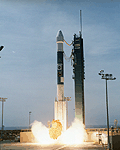
On 18 December 2005, after 5.8 years of successful operations, IMAGE's telemetry signals were not received during a routine pass. Currently, IMAGE has not responded to commands and a press release on this unfortunate event has been issued. The IMAGE mission was designed as a two-year mission but has exceeded all its scientific goals and has produced a fire hose of stunning images of the previously invisible region of space in the inner magnetosphere.
The Final Report of the IMAGE Failure Review Board has now been released. The most likely explanation of the failure was the result of an induced "instant trip" of the Solid Sate Power Controller (SSPC) supplying power to the transponder. Other possible, but very unlikely causes, could not be eliminated, however. The report as well as the full presentation of the review board presented on 04 April 2006 is available on the Mission Publications page.
The IMAGE spacecraft was launched from Vandenberg AFB on 25 March 2000, at 20:34:43 UT. IMAGE was the first satellite mission dedicated to imaging the Earth's magnetosphere, the region of space controlled by the Earth's magnetic field and containing extremely tenuous plasmas of both solar and terrestrial origin. Invisible to standard astronomical observing techniques, these populations of ions and electrons have traditionally been studied by means of localized measurements with charged particle detectors, magnetometers, and electric field instruments. Instead of such in situ measurements, IMAGE employed a variety of imaging techniques to "see the invisible" and to produce the first comprehensive global images of the plasma populations in the inner magnetosphere. With these images, space scientists were able to observe, in a way never before possible, the large-scale dynamics of the magnetosphere and the interactions among its constituent plasma populations.
IMAGE used neutral atom, ultraviolet, and radio imaging techniques to:
- Identify the dominant mechanisms for injecting plasma into the magnetosphere on substorm and magnetic storm time scales;
- Determine the directly driven response of the magnetosphere to solar wind changes; and,
- Discover how and where magnetospheric plasmas are energized, transported, and subsequently lost during substorms and magnetic storms.

